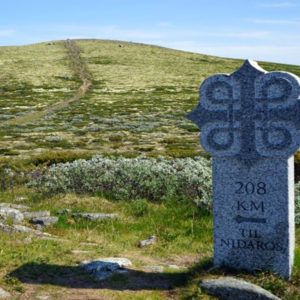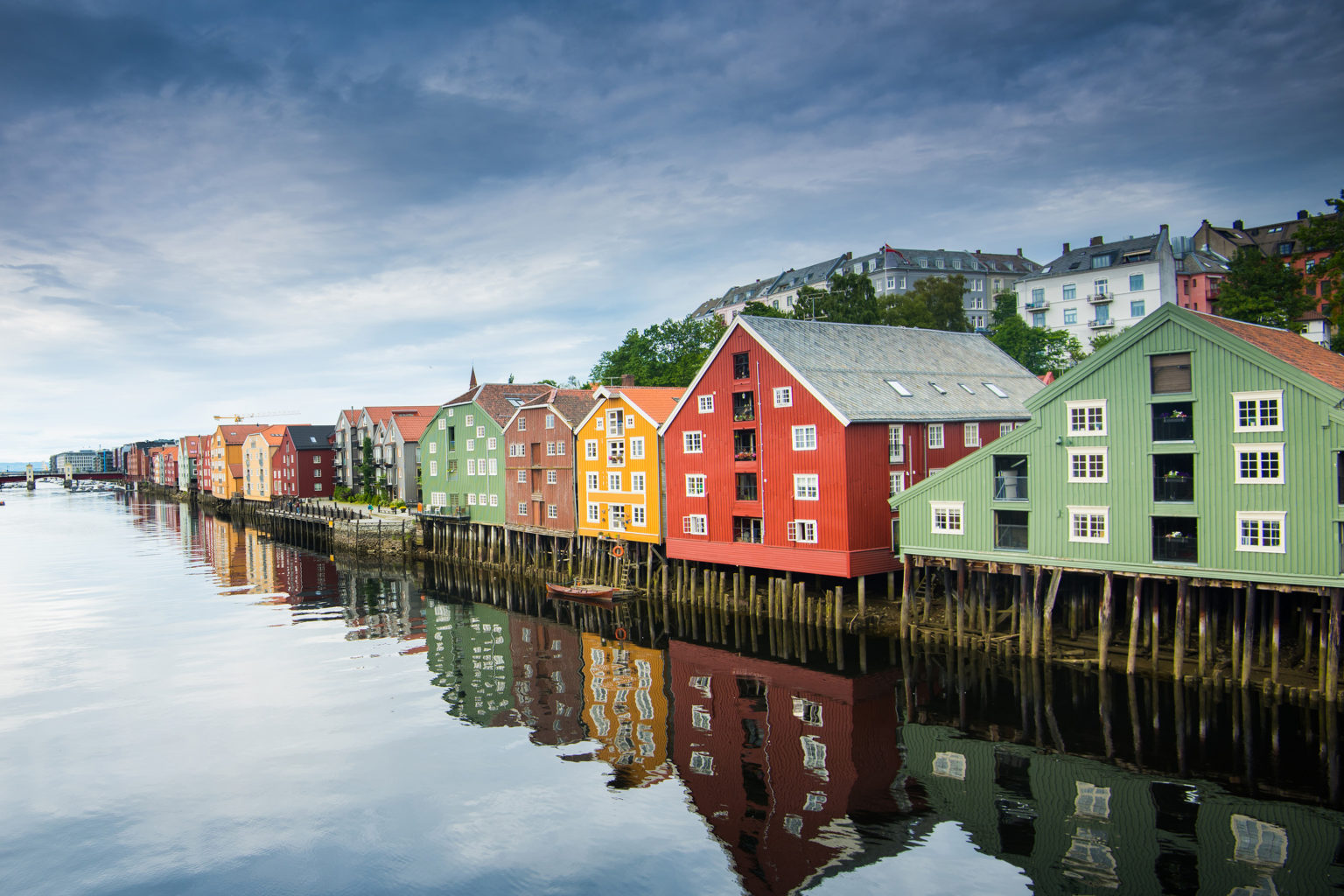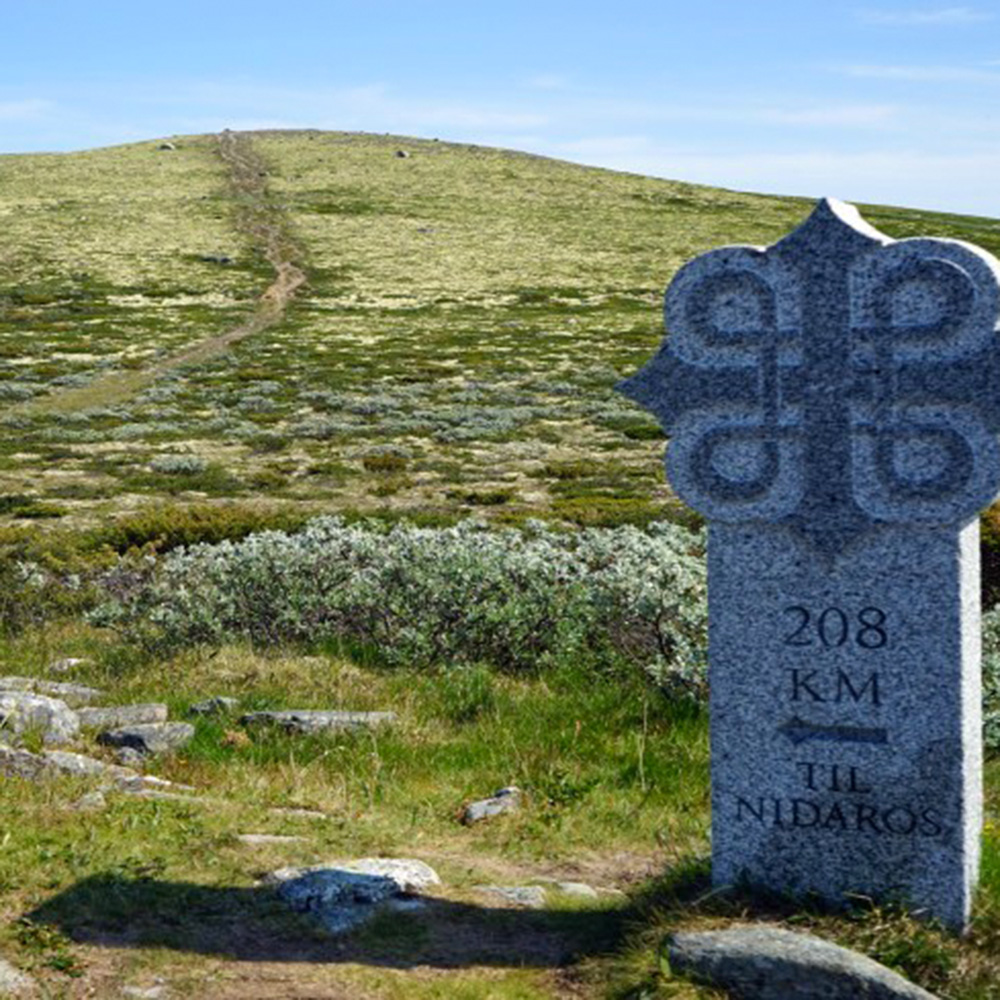Norway

The St. Olav’s Way, also known as St. Olavspaden in Norwegian, is a network of pilgrim routes in Norway that lead to the Nidaros Cathedral in Trondheim, which is the final resting place of St. Olav, the patron saint of Norway. The length of the St. Olav’s Way varies depending on the specific route taken, as there are several paths leading to Trondheim from different starting points.
One of the most popular routes is the Gudbrandsdalen path, which starts in Oslo and is approximately 643 kilometers (400 miles) long. Another well-known route is the Østerdalen path, which begins in southeastern Norway and is approximately 252 kilometers (157 miles) long.
St. Olaf’s story, mainly known through the Icelandic historian Snorri Sturluson, dates back to 995 when Olaf Haraldsson was born in southern Norway. After extensive Viking voyages, he was baptized in 1013 in Rouen, marking the beginning of his Christian influence. Returning to Norway in 1015, Olaf aimed to unite the country under Christianity, facing resistance due to his legislative changes. Forced into exile in 1028, he returned in 1030 to reclaim the throne but met his end in the Battle of Stiklestad on July 29, 1030.
Rumors of Olaf’s holiness spread posthumously, and in 1031, Bishop Grimketel canonized him. His remains were moved to St. Clement’s church in Nidaros, where the Nidaros Cathedral was later built in 1070, becoming a pilgrimage site for Europeans.
The map below shows the most popular route of Saint Olav, the Gudbrandsdalen path from Oslo to Trondheim. Soon we’ll be adding maps of the other routes as well.
For more information about the individual routes, please see “itinerary” below”.
Below you will find all the different itineraries you can follow along Saint Olav’s Way. As you can see, not all itineraries end in Trondheim but it is possible to connect two or more itineraries together based on the time you have available.
Gudbrandsdalsleden
Oslo –> Gjøvik/Hamar –> Trondheim
Distance: 643 km
Duration: 32 days
Click here for more details
St. Olavsleden
Selånger –> Stiklestad –> Trondheim
Distance: 580 km
Duration: 30 days
Click here for more details
Kystpilegrimsleia
Egersund –> Bergen –> Trondheim
Distance: 1080 km
Duration: 24 days
This itinerary is done almost entirely by boat along Norway’s coastline.
Click here for more details
Valldalsleden
Valldal –> Lesja –> Dovre mountain
Distance: 150 km
Duration: 7-8 days
Click here for more details
Borgleden
Halden –> Sarpsborg –> Ås –> Oslo
Distance: 176 km
Duration: 9 days
Click here for more details
Østerdalsleden
Trysil/Rena –> Tynset –> Trondheim
Distance: 320 km
Duration: 21 days
Click here for more details
Nordleden
Gløshaugen –> Stiklestad
Distance: 135 km
Duration: 7 days
Click here for more details
Romboleden
Tydal –> Selbu –> Trondheim
Duration: 150 km
Distance: 7 days
Click here for more details
Tunsbergleden
Larvik –> Tønsberg –> Bærum
Distance: 190 km
Duration: 9 days
Click here for more details

The Saint Olav’s Route is well-signposted, providing clear waymarking for pilgrims. The trail is marked with the iconic St. Olav’s cross symbol, typically painted on rocks, trees, and signposts along the way. In addition to the cross, there are often directional signs indicating distances to key destinations. This comprehensive waymarking system ensures that pilgrims can navigate the route with ease, fostering a sense of security and confidence throughout their journey towards Trondheim and the Nidaros Cathedral.
The Saint Olav’s Way pilgrim passport, also known as a “pilegrimspass” in Norwegian, is an essential document for pilgrims walking the St. Olav’s Way in Norway. It serves as a record of your pilgrimage journey and provides access to various accommodations, discounts, and spiritual experiences along the route.
The pilegrimspass is priced at 50 NOK and is available for purchase at all regional pilgrim centers and select locations (refer to the overview below). For those wishing to receive the passport ahead of their pilgrimage, it can be ordered from the online store at northernpilgrimshop.com.
Purpose of the Passport
Proof of Pilgrimage: It serves as evidence that you have walked the St. Olav’s Way pilgrimage.
Access to Accommodations: Some pilgrim accommodations along the route may require a pilgrim passport for verification.
Cultural and Spiritual Connection: The passport can be stamped at various churches, chapels, and significant sites along the way. Each stamp represents a symbolic connection to the spiritual and cultural heritage of the pilgrimage.
Stamping the Passport
You should aim to get your passport stamped at various locations along the way. This can be done at churches, pilgrim hostels, and other significant sites. Each stamp is a meaningful memento of your journey.
Discounts and Benefits
In some places, having a pilgrim passport may entitle you to discounts on accommodations, meals, and other services. This can be a nice perk for pilgrims.
Personal Information
The passport may have a section for personal details, allowing you to write your name, contact information, and any other relevant information.
Remember to keep your pilgrim passport safe throughout your journey, as it will serve as a cherished keepsake of your pilgrimage experience. It’s also a wonderful way to commemorate your spiritual journey and the cultural heritage of St. Olav’s Way.
The Olav Letter serves as official confirmation that you have completed the final stage, covering a minimum of 100 kilometers on any of the St. Olav Ways leading into Trondheim. Alternatively, if you have cycled the last 200 kilometers, you are also eligible.
To obtain the Olav Letter, you must personally present your pilgrim passport with the required stamps as proof. The Nidaros Pilgrim Center (Nidaros pilegrimsgård), situated adjacent to the Nidaros Cathedral in Trondheim, is the exclusive issuing location for the Olav Letter. For its precise location please see the map below.
Along the St. Olav’s Way, there are various options for accommodation to suit different preferences and budgets. Here are some common choices:
Click here for the 2023 list of accommodations along the Gudbrandsdalsleden.
Click here to find accommodation also along the other itineraries of St. Olav.
It’s recommended to plan your accommodations in advance, especially during peak pilgrimage seasons. Some places may require reservations, while others operate on a first-come, first-served basis. Make sure to check availability and book ahead if needed. Additionally, it’s a good idea to carry a pilgrim passport, as some accommodations may offer discounts to pilgrims.
The weather along the Saint Olav’s Way in Norway can vary greatly depending on the time of year and the specific region you are in. Here is a general overview of the seasons and typical weather conditions along the pilgrimage route:
Spring (March to May):
Summer (June to August):
Autumn (September to November):
Winter (December to February):
It’s important to note that weather in Norway can be quite changeable, and even in the summer, you should be prepared for a variety of conditions. It’s advisable to check the weather forecast regularly and to pack appropriate clothing for the season in which you plan to walk the St. Olav’s Way. Additionally, be aware of the specific challenges posed by winter conditions if you choose to walk during the colder months.
There are several guidebooks available in English to help you navigate and explore the Saint Olav’s Way in Norway. Here are a few popular options:
– St. Olav Ways Guide Book: Pilegrimsleden Valldalsleden
– St. Olav Ways I – The Gudbrandsdalen Path: From Oslo to Trondheim in 35 days
– St. Olav Ways II – St.Olavsleden: Encounters along the way. From Selånger to Trondheim in 27 days
– St. Olav Ways III- The Østerdalsleden Path: From Karlstad in Sweden to Trondheim in Norway
– The Pilgrim Road to Trondheim. Oslo to Nidaros Cathedral
Remember to check for the most up-to-date editions, as well as any recent updates or changes to the routes. Additionally, consider carrying a map or using GPS navigation along with your guidebook for added assistance during your pilgrimage.
On the Gudbrandsdalsleden and St. Olavsleden, numerous companies provide luggage transfer services for different stages of the routes. Below, you’ll find the details required for arranging luggage transfer within the designated areas. Accommodations along the St. Olav Ways collaborate closely with transport companies, assisting you in coordinating your luggage transport along the journey.
Here are some general rules for the luggage transport:
Terms of service:
For contact information and prices for this service, please view this section of the official Pilegrimsleden website.
For more information about the Saint Olav’s Way we invite you to visit the official Pilegrimsleden website.


© 2023 All Rights Reserved.